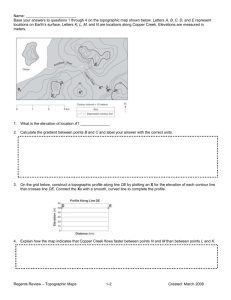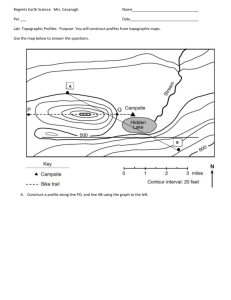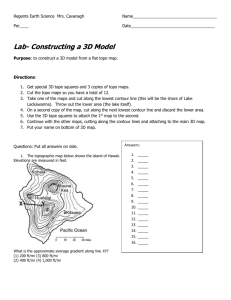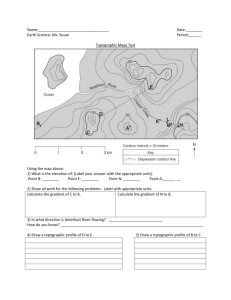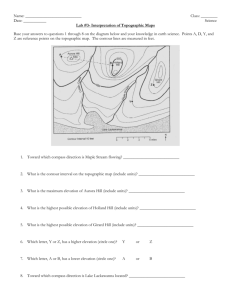Rocks and Minerals
advertisement
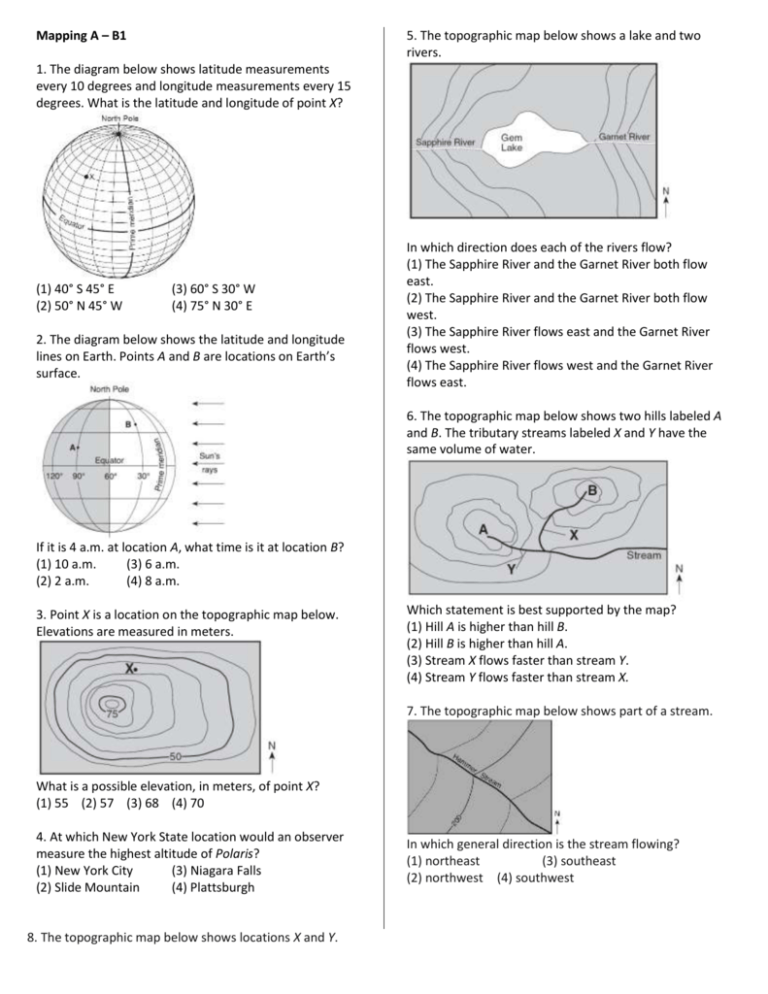
Mapping A – B1 5. The topographic map below shows a lake and two rivers. 1. The diagram below shows latitude measurements every 10 degrees and longitude measurements every 15 degrees. What is the latitude and longitude of point X? (1) 40° S 45° E (2) 50° N 45° W (3) 60° S 30° W (4) 75° N 30° E 2. The diagram below shows the latitude and longitude lines on Earth. Points A and B are locations on Earth’s surface. In which direction does each of the rivers flow? (1) The Sapphire River and the Garnet River both flow east. (2) The Sapphire River and the Garnet River both flow west. (3) The Sapphire River flows east and the Garnet River flows west. (4) The Sapphire River flows west and the Garnet River flows east. 6. The topographic map below shows two hills labeled A and B. The tributary streams labeled X and Y have the same volume of water. If it is 4 a.m. at location A, what time is it at location B? (1) 10 a.m. (3) 6 a.m. (2) 2 a.m. (4) 8 a.m. 3. Point X is a location on the topographic map below. Elevations are measured in meters. Which statement is best supported by the map? (1) Hill A is higher than hill B. (2) Hill B is higher than hill A. (3) Stream X flows faster than stream Y. (4) Stream Y flows faster than stream X. 7. The topographic map below shows part of a stream. What is a possible elevation, in meters, of point X? (1) 55 (2) 57 (3) 68 (4) 70 4. At which New York State location would an observer measure the highest altitude of Polaris? (1) New York City (3) Niagara Falls (2) Slide Mountain (4) Plattsburgh 8. The topographic map below shows locations X and Y. In which general direction is the stream flowing? (1) northeast (3) southeast (2) northwest (4) southwest What is the approximate gradient between X and Y? (1) 15 ft/mi (2) 20 ft/mi (3) 30 ft/mi (4) 60 ft/mi Mapping B2 - C Base your answers to questions 1 through 3 on the map below. The map shows the water depth, measured in feet, at the north end of one of the Finger Lakes. Points A and B are locations at the lake’s shoreline. Points X and Y are locations on the bottom of the lake. 1. On the map draw the 20-foot-depth isoline. The isoline must extend to the edge of the map. [1] 2. On the grid construct a profile along the line from point A to point B. Plot the depth along line AB by marking an X at each numbered point where a water depth is shown. Complete the profile by connecting the Xs with a smooth, curved line. The Xs for point A and point B have been plotted. [2] 3. Calculate the gradient between point X and point Y. Label your answer with the correct units. [1] Base your answers to questions 4 and 5 on the field map below. The field map shows temperatures, in degrees Fahrenheit, taken at several locations on a blacktop parking lot in New York State. The temperatures were recorded at 11:00 a.m. in early June. 4. On the field map draw the 70°F and 80°F isotherms. The isotherms should be extended to the edges of the map. [1] 5. Explain why the surface of this parking lot usually becomes warmer from 11:00 a.m. to 12 noon each day. [1] ~~~~~~~~~~~~~~~~~~~~~~~~~~~~~~~~~ Base your answers to questions 6 through 8 on the topographic map below, which shows three glaciers found in Alaska. Dashed lines show the inferred location of the front edge of each glacier in 1948, 1964, and 1980. Solid lines show the location of the front edge of each glacier in 1998. Points A and B show the location of the front edge of the Taku Glacier in 1948 and 1998. Elevations are in feet. 6. Determine the rate, in miles per year, that the front edge of the Taku Glacier moved between point A and point B. [1] 7. What is the contour interval on this map? [1] 8. If these glaciers completely melted, what two pieces of evidence would a scientist most likely find to indicate that glaciers had existed in this area? [1] Base your answers to questions 9 through 12 on the topographic map below, which shows a small island in an ocean. Points A, B, C, and D represent surface locations on the island. The symbol 134 represents an elevation on the hilltop. Elevations are measured in feet and distances are measured in miles. 9. On the grid provided above construct a profile along line AB by plotting an X for the elevation of each contour line that crosses line AB. Connect the Xs with a smooth, curved line to complete the profile. [1] 10. Calculate the gradient of Mud Creek between points C and D and label your answer with the correct units. [1] 11. State the compass direction toward which Mud Creek flows. [1] ________________________________ 12. Explain how the contour lines on the map indicate that the north side of the island has the steepest slope. [1] Base your answers to questions 13 through 15 on the topographic map below. Points A and B are reference points on the map. The symbols show the highest elevations on Eagle Hill and Timony Hill. Elevations are shown in feet. 13. Identify the general compass direction toward which Auroro Creek is flowing. [1] ____________________ 14. State a possible elevation of the top of Patriot Hill. [1] _____________________________________ 15. On the grid construct a topographic profile along line AB by plotting an X for the elevation of each contour line that crosses line AB. Connect the plotted Xs with a smooth, curved line to complete the profile. Points A and B have been plotted. [2] Base your answers to questions 16 through18 on the topographic map below. Points A, B, X, and Y are locations on Earth’s surface. 16. On the grid construct a topographic profile of the land surface along line AB by plotting an X for the elevation of each contour line that crosses line AB. Connect the Xs with a smooth, curved line to complete the profile. [1] 17. Toward which compass direction is Snapper Creek flowing? [1] ________________________________ 18. Calculate the gradient between points X and Y. Units must be included in your answer. [1]

